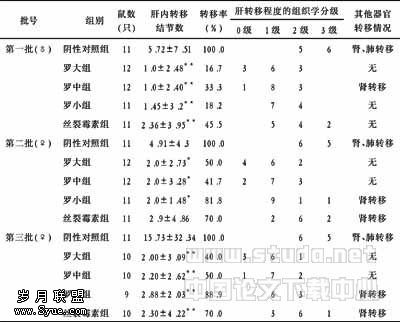茶多酚对微卫星不稳定结直肠癌裸小鼠的抗肿瘤作用及其作用机制
作者:戴功建, 金黑鹰, 丁义江, 夏建国, 刘秀芳, 刘飞, 谈瑄忠, 耿建祥
【摘要】 目的:探索茶多酚对微卫星不稳定结直肠癌裸小鼠的作用及其作用机制。
方法:采用hMSH2缺失结肠癌细胞株Lovo细胞建立裸鼠的皮下瘤模型,4周后使用皮下瘤接种法建立结肠造口结肠癌原位移植瘤模型。40只模型裸鼠分为模型组和50、75、100 mg/kg茶多酚组。腹腔注射茶多酚5 d后,肿瘤抑制率,并检测肿瘤微卫星不稳定情况和转化生长因子β1(transforming growth factor?β1, TGF?β1)、TGF?β2和胰岛素样生长因子(insulin?like growth factor, IGF)片段的变化情况。
结果:使用50、75和100 mg/kg 3个剂量茶多酚治疗后,在1、2、3和4周末,治疗组和模型组肿瘤抑制率比较,差异有统计学意义(P<0.01);3个治疗组之间比较,差异无统计学意义。使用茶多酚治疗后肿瘤微卫星标志趋于稳定。
结论:茶多酚对错配修复基因缺失的结直肠癌有明显抑制作用,其作用机制可能与抑制微卫星不稳定有关。
【关键词】 茶多酚; DNA错配修复; 基因缺失; 结直肠癌; 微卫星不稳定性; 裸小鼠
Methods: A colostomy was performed on the caecum of nude mice. Tumor fragments collected from the subcutaneous tumor of hMSH2?absence colon carcinoma Lovo cell line were surgically implanted onto the submucosa of the caecum during colostomy to establish the model. Then, the nude mice were divided into untreated group and 50, 75 and 100 mg/kg tea polyphenols groups. The mice in tea polyphenols?treated groups were given intra?abdominal injection of 50, 75 and 100 mg/kg tea polyphenols respectively. The inhibition rates of tumors were calculated, and microsatellite instability (MSI) and the alteration of transforming growth factor?β1 (TGF?β1), TGF?β2 and insulin?like growth factor (IGF) were detected by Genescan method at different times after the injection.
Results: The tumor volumes of the three groups began to decrease at the 1st week and decreased most greatly from 2 to 3 weeks after treatment, and then the tumors tended to increase. The study found that tea polyphenols could inhibit the tumor growth. The tumor inhibition rates in the three treated groups were significantly higher than those in untreated group 1, 2, 3 and 4 weeks after treatment (P<0.01). Detection of MSI showed that the colorectal tumor in the untreated group presented with four MSI signs, including BAT?25, D2S123, D5S346 and D17S250, and TGF?β1, TGF?β2, IGF expressions. After using the tea polyphenols, the microsatellite tended to become stable.
Conclusion: Tea polyphenols can inhibit the mismatch?repair?gene deficient colorectal cancer in nude mice by down?regulating the microsatellite instability.
Keywords: tea polyphenols; DNA mismatch repair; gene deletion; colorectal neoplasms; microsatellite instability; nude mice
茶多酚是一种从茶叶中提取的混合物,近年来的研究表明,茶多酚对体内的多种肿瘤都有一定的抑制作用。流行病学研究发现,长期饮用茶叶可降低前列腺癌的发生率[1];实验研究发现,茶叶对包括结直肠癌在内的许多肿瘤细胞都有抑制作用[2]。茶多酚主要通过抗氧化作用,使细胞产生凋亡,而发挥抗肿瘤作用[3]。微卫星不稳定性(microsatellite instability, MSI)结直肠癌环氧化酶(cyclooxygenase, COX)系统表达受抑制,因此茶多酚可能通过其他途径发挥抑制肿瘤生长的作用[4, 5]。MSI结直肠癌约占结直肠癌的20%~30%,是由于错配修复基因表达缺失,DNA复制错误增加,微卫星不稳定,导致结直肠癌发生[6]。通过抑制基因突变是否可以抑制MSI结直肠癌呢?我们在前期研究中发现,茶多酚对错配修复基因表达缺失的结直肠癌细胞株有抑制[7],本研究探索茶多酚对错配修复基因表达缺失的结直肠癌裸鼠模型的作用。
1 材料与方法
1.1 实验材料
1.1.1 细胞株 hMSH2缺失结肠癌细胞株Lovo细胞,购自院上海细胞生物研究所。
1.1.2 茶多酚制备 茶多酚购自杭州茶叶有限公司,以蒸馏水配制成50 mg/ml的溶液作为母液,灭菌后备用。
1.1.3 实验动物 BALB/c nu/nu裸鼠42只,SPF级,购自北京科丽华实验动物中心,动物试验许可证号为SCXK(京)2007?0001,动物合格证号为0085458。体质量24~28 g,雌雄各半,分笼饲养于独立送风笼具,室温控制在24~25 ℃,相对湿度50%~60%。
1.2 实验方法
1.2.1 细胞株及细胞培养 Lovo细胞以含10%小牛血清的RPMI?1640培养基,在37 ℃、5% CO2培养箱中培养。0.25%胰酶?乙二胺四乙酸消化后,PBS洗2次,调整细胞浓度制成1×106/ml的细胞悬液。
1.2.2 裸鼠皮下瘤模型的建立 取2只裸鼠用于肿瘤皮下接种。裸鼠颈部右侧皮肤消毒,用一次性1 ml注射器将Lovo细胞悬液注入皮下,0.2 ml/只。注射完毕后,对注射部位进行观察,约4周成瘤。
1.2.3 裸鼠结肠造口原位移植瘤模型建立 氯胺酮(0.17 mg/g 体质量)裸鼠腹腔注射麻醉,左腹部碘酊消毒,在左下腹部皮肤及腹膜剪一小口,将裸鼠盲肠提出腹壁约0.5 cm,以5.0缝线将盲肠与周围皮肤缝合固定。术后注意补充葡萄糖生理盐水,加强营养,术后2~3 d造口部位结痂,约1周结痂脱落,露出肠道。术后2周,取裸鼠皮下接种肿瘤,切取1 mm3的肿块2块,种植于造口处盲肠,待肿瘤生长至直径约5 mm时开始进行茶多酚处理。
1.2.4 分组及用药 选取结肠造口结肠癌原位移植模型裸鼠40只,分为模型组和50、75、100 mg/kg茶多酚组,每组10只。茶多酚组予相应剂量茶多酚腹腔注射,1次/d,模型组腹腔注射等体积生理盐水,连续注射5 d,观察肿瘤增长情况。
1.2.5 肿瘤体积和抑制率 分别于用药前和用药后1、2、3、4和5周末测量在体肿瘤大小,计算肿瘤体积和肿瘤抑制率。计算公式分别为[8]:肿瘤体积=(肿瘤长轴×肿瘤短轴2)/2;肿瘤抑制率=(用药后肿瘤体积-用药开始肿瘤体积)/用药开始肿瘤体积。
1.2.6 肿瘤组织中MSI以及转化生长因子β1、转化生长因子β2和胰岛素样生长因子片段的大小变化检测 分别于用药前和用药后3、7、14、21和28 d于肿瘤处取材,采用Genescan法检测微卫星不稳定情况,并检测转化生长因子β1(transforming growth factor?β1, TGF?β1)、TGF?β2和胰岛素样生长因子(insulin?like growth factor, IGF)片段的大小变化,方法、使用试剂及引物序列[6, 9]。抽提基因组DNA,以聚合酶链反应(polymerase chain reaction, PCR)方法扩增上述片段,反应体系20 μl,反应条件为:95 ℃预变性15 min,94 ℃变性1 min,56 ℃退火1 min,72 ℃延伸1 min,72 ℃充分延伸25 min。共30个循环。取1 μl PCR反应产物与0.4 μl LIZ (内标)和9 μl甲酰胺混合,然后在ABI3100?Avant测序仪上毛细管电泳法电泳45 min。Datacollection软件自动进行数据收集和处理,并生成原始的样品数据文件。
1.3 统计学方法 采用SPSS 10.0统计软件进行统计分析,计量资料数据采用x±s表示,Student?t检验进行计量资料比较,分别比较1、2、3、4周模型组和组肿瘤抑制率;同时以方差分析比较各治疗组间的肿瘤抑制率差异。
2 结果
2.1 使用茶多酚处理结肠造口的结肠癌原位移植模型的结果 50、75和100 mg/kg茶多酚注射后,3组肿瘤1周时开始出现缩小,2~3周时肿瘤缩小最多,在3周以后肿瘤开始增长;而空白对照组肿瘤一直处于增长状况。在1、2、3和4周,治疗组和模型组肿瘤抑制率比较差异有统计学意义(P<0.01);以方差分析进行3个治疗组之间的肿瘤抑制率的比较,差异无统计学意义(P>0.05)。见图1。
图1 茶多酚治疗后肿瘤抑制率(略)
Figure 1 Tumor inhibition rates after tea polyphenols injection in different groups
**P<0.01, vs tea polyphenols?treated groups, n=10.
2.2 肿瘤MSI以及TGF?β1、TGF?β2和IGF基因片段大小变化 在模型组肿瘤组织中能扩增到的4个微卫星标志(BAT?25、D2S123、D5S346和D17S250)和TGF?β1、TGF?β2、IGF,出现了微卫星标志和一些简单重复序列的延长和缩短,见表1。但是在使用茶多酚治疗后,微卫星标志和携带简单重复序列的基因的变异出现稳定趋势。以75 mg/kg茶多酚处理后的肿瘤的微卫星标志以及TGF?β1、TGF?β2和IGF的变化见表2。
表1 模型组MSI标志以及TGFβ1、TGFβ2和IGF的变化(略)
Table 1 Changes of MSI signs and TGFβ1, TGFβ2 and IGF in untreated group
表2 75 mg/kg茶多酚治疗后MSI标志以及TGF?β1、TGF?β2和IGF的变化(略)
Table 2 Changes of MSI signs and TGF?β1, TGF?β2 and IGF after 75 mg/kg tea polyphenols treatment
3 讨论
茶多酚具有抗肿瘤和抗基因突变的作用。张春玲等[10]使用Ames研究发现,茶多酚可以恢复亚硝胺导致的基因突变。使用茶多酚的抗突变作用能否抑制MSI结直肠癌呢?本研究使用错配修复基因hMSH2缺失的Lovo细胞作为研究对象,建立了结肠造口的结肠癌原位移植模型,该模型可以反复取样,便于治疗过程中观察肿瘤的分子生物学变化。研究中发现,3个不同剂量茶多酚均可以使肿瘤缩小,特别在治疗后3周内肿瘤缩小明显。以往的研究中没有见到相同的报道,特别在使用非细胞毒性药物对肿瘤治疗的研究中,在在体水平很难发现肿瘤缩小。其机制是什么呢?进行微卫星不稳定检测发现,模型组肿瘤组织能扩增到的4个微卫星标志以及TGF?β1、TGF?β2和IGF均出现延长或缩短,提示Lovo在增殖过程表现出简单重复序列基因的明显突变,符合Lovo细胞的增殖特点。但是在使用茶多酚治疗后,3 d可以检测到微卫星标志以及TGF?β1、TGF?β2和IGF等基因的变化,但是在1、2和3周后这些微卫星序列有趋于稳定的趋势,提示茶多酚可能是抑制了这些含有简单重复序列基因的突变而导致抗肿瘤的作用。但是,茶多酚是怎样抑制这些基因发生突变,其机制需要做进一步的研究。
【参考文献】
1 Siddiqui IA, Saleem M, Adhami VM, et al. Tea beverage in chemoprevention and chemotherapy of prostate cancer. Acta Pharmacol Sin. 2007; 28(9): 1392?1408.
2 Shukla IA Tea and cancer chemoprevention: a comprehensive review. Asian Pac J Cancer Prev. 2007; 8(2): 155?66.
3 Yang CS, Lambert JD, Hou Z, et al. Molecular targets for the cancer preventive activity of tea polyphenols. Mol Carcinog. 2006; 45(6): 431?435.
4 Wu AW, Gu J, Ji JF, et al. Role of COX?2 in carcino?genesis of colorectal cancer and its relationship with tumor biological characteristics and patients' prognosis. World J Gastroenterol. 2003; 9(9): 1990?1994.
5 Karnes WE Jr, Shattuck?Brandt R, Burgart LJ, et al. Reduced COX?2 protein in colorectal cancer with defective mismatch repair. Cancer Res. 1998; 58(23): 5473?5477.
6 Jin HY, Liu X, Li VK, et al. Detection of mismatch repair gene germline mutation carrier among Chinese population with colorectal cancer. BMC Cancer. 2008; 8: 44.
7 Liu XF, Jin HY, Ding YJ, et al. Inhibitory effect of Chinese herbs with anti?mutation activity on a mismatch?repairgene?deficient colorectal cancer cell line. Shi Jie Hua Ren Xiao Hua Za Zhi. 2007; 15(20): 2201?2204. Chinese with abstract in English.
刘秀芳, 金黑鹰, 丁义江, 等. 抗突变中药对错配修复基因缺失结直肠癌细胞的抑制作用. 世界华人消化杂志. 2007; 15(20): 2201?2204.
8 Nyati MK, Symon Z, Kievit E, et al. The potential of 5?fluorocytosine/cytosine deaminase enzyme prodrug gene therapy in an intrahepatic colon cancer model. Gene Ther. 2002; 9(13): 844 849.
9 Nash GM, Gimbel M, Shia J, et al. Automated, multiplex assay for high?frequency microsatellite instability in colorectal cancer. J Clin Oncol. 2003; 21(16): 3105?3012.
10 Zhang CL, Hu JF, Qu JB, et al. Detecting antimutagenesis of Chinese herbal medicines and green tea by Ames test. Wei Sheng Du Li Xue Za Zhi. 2002; 16(1): 66. Chinese.
张春玲, 胡峻峰, 曲江斌, 等. Ames试验检测几种中草药及绿茶的抗诱变作用. 卫生毒杂志. 2002; 16(1): 66.











